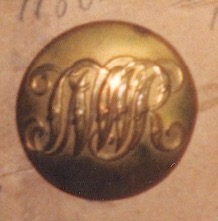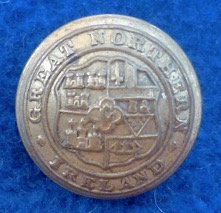Fintona Branch
Owner Londonderry and Enniskillen Railway
Opened January 1854 (horse)
Operator Londonderry and Enniskillen Railway
Taken over (operation) 1st January 1860 (Dundalk and Enniskillen Railway)
Name changed (lessee) 1862 (to the Irish North Western Railway)
Name changed (lessee) 1st January 1876 (to the Great Northern Railway of Ireland), following the amalgamation of the INWR and several other railway companies
Taken over (owner) 1883 (Great Northern Railway of Ireland), following the formal absorption of the Londonderry and Enniskillen Railway by the GNRI
Nationalised (GNRI) 1st October 1953 - operated jointly by the Irish and British governments under the auspices of the Great Northern Railway Board
Closed 30th September 1957
Length 1100 yards
Gauge 5ft 3ins
Button description (Pattern 1) Script initials 'INWR'
Materials known Brass
Button Line reference [None]
Button description (Pattern 2) Quartered shield with the arms of Dublin, Londonderry, Enniskillen and Belfast, surrounded by the title: ‘Great Northern Ireland’
Materials known Brass, nickel, black horn
Button Line reference [None]
Comments Photographs taken before 1900 appear not to have survived, so visual evidence that staff wore uniforms prior to this date is unfortunately lacking. However, given that the men who worked the branch were first and foremost railwaymen, it would be astonishing if they had not worn uniforms. The Pattern 1 button is an extremely rare survivor, and would presumably have been worn under the tenure of the Irish North Western Railway (1862 to 1876). As far as I am aware, no buttons have survived for either of the earlier companies - the Londonderry and Enniskillen Railway, and the Dundalk and Enniskillen Railway - and it is currently unclear whether they ever existed.
The Fintona Branch was actually a horse-operated railway line, and had no street running whatsoever, so was most definitely not a street tramway. The reason for its inclusion here, is that from 1883 through to its closure in 1957, it was worked using a vehicle which was identical in every respect to a horse-drawn tramcar, and which was built by one of the main British tramcar manufacturers.

